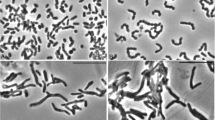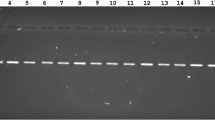Abstract
Five microorganisms, three bacteria and two yeasts, capable of degrading Tapis light crude oil were isolated from oil-contaminated soil in Bangkok, Thailand. Soil enrichment culture was done by inoculating the soil in mineral salt medium with 0.5% v/v Tapis crude oil as the sole carbon source. Crude oil biodegradation was measured by gas chromatography method. Five strains of pure microorganisms with petroleum degrading ability were isolated: three were bacteria and the other two were yeasts. Candida tropicalis strains 7Y and 15Y were identified as efficient oil degraders. Strain 15Y was more efficient, it was able to reduce 87.3% of the total petroleum or 99.6% of n-alkanes within the 7-day incubation period at room temperature of 25 ± 2 °C.
Similar content being viewed by others
References
Atlas RM (1981) Microbial degradation of petroleum hydrocarbons: an environmental perspective. Microbiological Reviews 45: 180- 209
Atlas RM (1984) Petroleum Microbiology. Macmillan Publishing Company, New York
Barnett JA, Payne RW & Yarrow D (1983) Yeasts: Characteristics and Identification. Cambridge University Press, London
Bertrand JC, Rambeloarisoa E, Rontani JF, Gicesti G & Mattei G (1983) Microbial degradation of crude oil in sea water in contimuous culture. Biotechnology Letters 5: 567- 572
Dibble JT & Bartha R (1976). Effect of iron on the biodegradation of petroleum in seawater. Applied and Environmental Microbiology 31: 544- 550
Evan EGV & Richardson MD (1989) Medical Mycology: A Practical Approach. Oxford University Press, London
Fedorak PM & Westlake WS (1981) Microbial degradation of aromatics and saturates in Prudhoe bay crude oil as determined by glass capillary gas chromatography. Canadian Journal of Microbiology 27: 432- 443
Jordan RE & Payne JR (1980). Fate and weathering of petroleum spills in the marine environment. Ann Arbor Science
Jobson, A., F.D. Cook, and D.W.S. Westlake (1972). Microbial utilization of crude oil. Applied Microbiology 23: 1082- 1089
Koch AL (1981) Growth measurement. In: Gerhardt P (Ed) Manual of Methods for General Bacteriology (pp 179- 207). American Society for Microbiology, Washington, D.C.
Krieg NR (1981) Enrichment and isolation. In: Gerhardt P (Ed) Manual of Methods for General Bacteriology (pp 112- 142). American Society for Microbiology, Washington, D.C.
Lodder J (1970) The Yeasts: A Taxonomic Study. 2nd edition. North-Holland Publishing Company, The Netherlands
Matisova E, Juranyiova E, Kuran E & Brandssteterova E (1991). Analysis of multicomponent mixtures by high-resolution capillary gas chromatography and combined gas chromatographymass spectrometry: I. Aromatics in a hydrocarbon matrix. Journal of Chromatography 552: 302- 312
Matisova E, Vodny S, Skrabakova S & Onderova M. (1993). Analysis of multicomponent mixtures by high-resolution capillary gas chromatography and combined gas chromatography-mass spectrometry: II. Trace aromatics in an n-alkane matrix. Journal of Chromatograhy 629: 309- 320
Olivieri R, Bacchin P, Robertiello A, Oddo N, Degen L & Tonolo A (1976). Microbial degradation of oil spills enhanced by a slow-release fertilizer. Applied and Environmental Microbiology 31: 629- 634
Oudot J (1984) Rates of microbial degradation of petroleum components as determined by computerized capillary gas chromatography and computerized mass spectrometry. Marine Environmental Research 13: 277- 302
Oudot J (1990) Selective migration of low and medium molecular weight hydrocarbons in petroleum-contaminated terrestrial environments. Oil & Chemical Pollution 6: 251- 261
Oudot J (1994) Soil pollution by petroleum products and treatments. Analysis Magazine 22: 16- 18
Oudot J & Dutrieux E (1989) Hydrocarbon weathering and biodegradation in a tropical estuarine ecosystem. Marine Environmental Research 27: 195- 213
Rungroengsilp C (1988) Oil contaminated water: problems and management. Journal of Environment 12: 84- 91 (in Thai)
Sorkhoh NA, Ghannoum MA, Ibrahim AS, Stretton RJ & Radwan SS (1990) Crude oil and hydrocarbon-degrading strains of Rhodococcus rhodochorus isolated from soil and marine environment in Kuwait. Environmental Pollution 65: 1- 17
Sorkhoh NA, Glannoum MA, Ibrahim AS, Stretton RJ & Radwan SS (1991). Growth of Candida albicans in the presence of hydrocarbons: A correlation between sterol concentration and hydrocarbon uptake. Applied Microbiology and biotechnology 34: 509- 512
Weissenfelds WD, Beyer M, Klein J (1990) Degradation of phenanthrene, fluorene and fluoranthene by pure bacterial cultures. Applied Microbiology and Biotechnology 32: 479- 484
Rights and permissions
About this article
Cite this article
Palittapongarnpim, M., Pokethitiyook, P., Suchart Upatham, E. et al. Biodegradation of crude oil by soil microorganisms in the tropic. Biodegradation 9, 83–90 (1998). https://doi.org/10.1023/A:1008272303740
Issue Date:
DOI: https://doi.org/10.1023/A:1008272303740




